How Do You Know if Your Hdmi Is 2.0
HDMI Explained
According to the HDMI Forum website, more than than one,700 manufacturers have sold over 8 billion HDMI-enabled devices, making HDMI the nearly popular manner to transmit uncompressed audio and video betwixt a source and a receiver or display.
What is HDMI?
HDMI means High-Definition Multimedia Interface, a standard for simultaneously transmitting digital video and audio from a source, such every bit a estimator or Idiot box cable box, to a computer monitor, TV or projector. Originally adult by a consortium of electronics manufacturers, it has been widely adopted with near all televisions and calculator monitors supporting the interface.
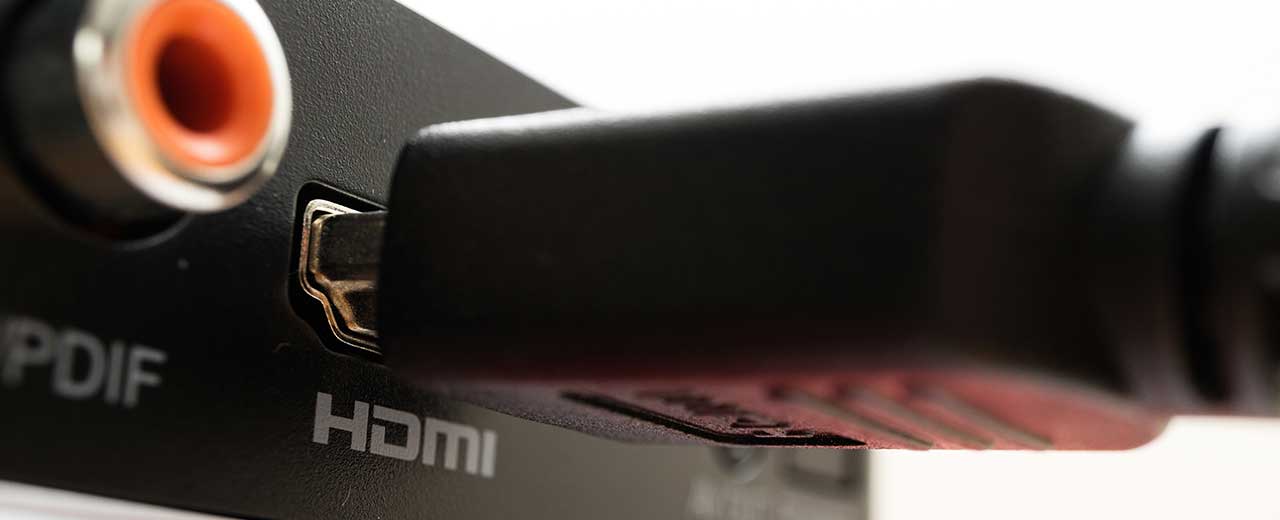
The goal of the HDMI initiative back in 2002 was to improve on existing connectivity standards (e.g. DVI, component video) past creating a smaller connector, adding back up for embedded sound and delivering a higher resolution video signal. Such was HDMI's success that by 2008, shipments of HDMI-enabled devices exceeded those of DVI. By the stop of 2009, all HDTVs had at to the lowest degree one HDMI port.
HDMI Cables
The HDMI interface allows a port to send high-resolution digital video, theatre-quality audio and device commands through an HDMI connector and downwards a single HDMI string, each designed to support a video resolution and features in the HDMI specification.
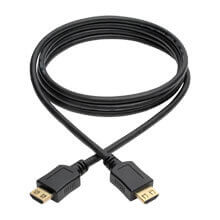
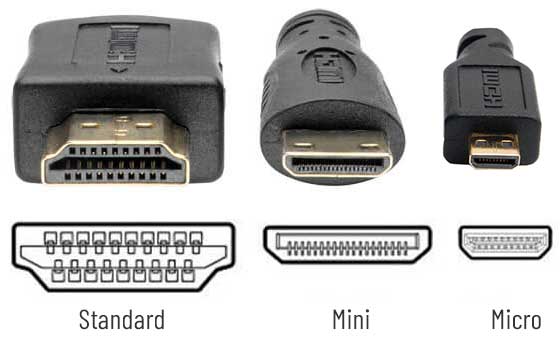
HDMI connectors are available in three sizes: standard, mini and micro.
There are likewise different types of HDMI cable (meet the nautical chart below). Non all cables utilise the logo but the cable specifications should indicate whether it is Standard, High Speed, Premium High Speed or Ultra High Speed. If the type is non indicated, assume Standard.
HDMI Ports and Connectors
The majority of HDMI connectors in use today are the Type A (Standard), Type C (Mini) and Type D (Micro) shown below. HDMI Blazon B (Dual Link) was developed for very loftier-resolution displays but was never used. Also non shown is the HDMI Blazon Eastward connector which is intended for automotive and industrial applications.
The Standard HDMI connector (Type A) is the well-nigh widely used of the five HDMI connector types. These 19-pin connectors can be establish on almost every brand of TV, reckoner monitor, game console, streaming device and desktop computer.
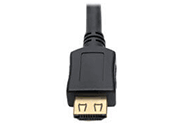
Mini HDMI connectors (Blazon C) also have 19-pins and support the same features every bit the full-sized Blazon A connector in a smaller, more than meaty class factor. Considering of its smaller size, it is typically used on portable devices such every bit DSLR cameras and tablets.
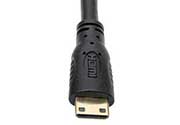
The smallest HDMI connector, Micro HDMI (Type D), is most one-half the width of the Mini HDMI connector yet still retains the total functionality of its larger siblings. Micro HDMI connectors are used on small, portable devices such every bit phones.
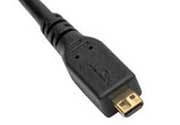
Cables are bachelor in male and female versions, with space-saving right-angled connectors and gripping or locking connectors.
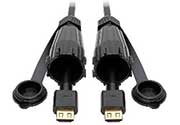
IP68 HDMI Connector
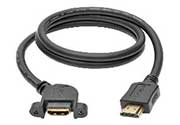
Panel Mount HDMI Connector
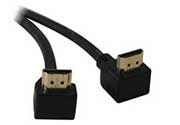
Right-Angled HDMI Connector
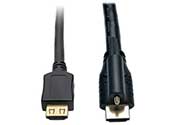
Locking and Gripping
HDMI Connectors
HDMI cable is considered low voltage and so y'all can install it inside a wall. HDMI faceplates requite a make clean, finished appearance and have a female connector on the internal side, making termination easy. HDMI keystones are besides bachelor for digital signage applications and big conference facilities with many displays that are fed from a fundamental location.
Gripping and Locking HDMI Connectors
HDMI connectors practise not latch like DisplayPort connectors simply some do provide a bound mechanism that makes the bract of a male connector grip the receptacle and makes it less likely that the cable will be accidentally pulled out. If an HDMI device may be subject to vibration or accidental movement, use a connector with a screw lock.
Which is best... in-wall HDMI cable or wireless HDMI?
A cablevision connection is a relatively inexpensive option that gives a stiff, reliable betoken but can exist difficult to install, it's express to ane location and a distance of 25-50-ft., depending on the resolution. Longer distances require an active cable or HDMI extender. A wireless HDMI extender is much easier to install, can be easily relocated and can broadcast a high-resolution video signal to multiple receivers.
Note: In-wall HDMI cables have a CL2 or CL3 rating. This ways that the cable jacket is fire resistant and suitable to low-voltage in-wall applications.
Is there a difference in functionality betwixt the Standard, Mini and Micro HDMI connectors?
All iii connectors have the same 19 pins, merely some may have unlike pivot assignments. Functionally, they all support the resolutions and features of HDMI i.4 onwards.
Tin can a USB-C Port be used to Transmit HDMI to a Monitor?
Yes. In Alt Mode, some of the pins in a USB-C connector are used to transmit other protocols. This allows the widely adopted USB-C port/connector to be used for more than than just USB data or power. To engagement, there are four Alternate Modes: DisplayPort, Mobile High-Definition Link (MHL), Thunderbolt and HDMI. HDMI Alt-Mode supports all of the features of HDMI 1.4b, including video resolutions of 4K @ 30 Hz and to a higher place.
I need an HDMI cable for my 4K TV. What should I buy?
Buy a Loftier Speed HDMI cable that supports at to the lowest degree HDMI i.4, the starting time HDMI standard to back up 4K signals. To get a 4K picture, all components must support 4K: the cable box or streaming service, the HDMI cable and the Tv set. If yous are using an erstwhile Standard HDMI cable purchased earlier 2009, it will not have the bandwidth to carry a 4K HDR betoken.
Evolution of the HDMI Standard
| Specification | Year | Video | Audio Support | ||
|---|---|---|---|---|---|
| Max. Resolution Refresh Rate* | Max. Transmission Charge per unit** | HDR | |||
| HDMI 1.0 | 2002 | 1080p @ 60 Hz | 4.95 Gb/s | No | 8 audio channels |
| HDMI 1.i/ane.2 | 2005 | 1440p @ thirty Hz | four.95 Gb/s | No | DVD-Audio, One-Scrap Sound |
| HDMI 1.iii/1.iv | 2009 | 4K @ threescore Hz | 10.ii Gb/due south | No | ARC, Dolby TrueHD, DTS-Hd |
| HDMI 2.0 | 2013 | 5K @ 30 Hz | xviii.0 Gb/s | Aye | HE-AAC, DRA, 32 audio channels |
| HDMI 2.i | 2017 | 8K @ 30 Hz | 48.0 Gb/due south | Yes | eARC |
* College refresh rates are possible using Display Stream Compression (DSC).
** HDMI encodes data and uses some of the available bandwidth to ensure the integrity of the indicate. This means that the actual information rate is something less than the maximum transmission charge per unit. For example, under HDMI 2.one, the maximum transmission rate is 48 Gbps simply the maximum date rate is 42.vi Gbps.
HDMI ane.0
- Initial release of the HDMI standard
- Audio and video interface for the transfer of video and audio over a single cable
- Data transfer up to iv.95 Gbps
- 1080p at 60 frames per 2nd (UXGA)
- 8-channels of 192kHz/24-bit uncompressed audio (PCM)
- Playback of standard Blu-ray video and audio
HDMI 1.1/1.2
- DVD Sound
- Support for YCbCr color space
- Back up for low voltages sources, such as PC video cards using PCI Limited
- HDMI Standard (Type A) connector for PC applications
- Consumer Electronic Control (CEC)
HDMI 1.iii/1.3a
- Increased bandwidth to 10.2 Gb/south
- Increased colour depth to 10-scrap, 12-chip, or 16-bit per aqueduct ("Deep Color")
- xvYCC color space back up
- HDMI Mini connector (Type C) for use with portable devices such as camcorders
- Support for Dolby TrueHD and DTS-Hd Principal Audio formats
HDMI ane.4/one.4a
- Support for HDMI Ethernet Channel (HEC)
- Support for 3840 x 2160 at 30Hz and 4096 ten 2160 at 24Hz
- Sound Return Channel (ARC)
- HDMI Micro connector (Blazon D) for utilize with phones
HDMI 2.0
- Increased bandwidth to 18 Gb/south
- 4K at 60 Hz
- 8b/10b signal encoding
- Support for 32 audio channels
- Support for ultra-wide 21:9 movie theater aspect ratio
HDMI 2.1
- Increased bandwidth to 48 Gb/s
- Resolutions up to 10K at 120 frames per second
- Dynamic HDR
- Display Stream Pinch (DSC) i.2a
- Enhanced Audio Return Channel (eARC)
HDMI Features
Transition-Minimized Differential Signaling (TMDS) – When digital data is transmitted, especially over long distances, it is susceptible to noise and signal loss. TMDS is a way of encoding an HDMI signal to protect information technology from interference equally it travels from source to receiver. It works like this:
- The sending device encodes the signal, organizing the ones and zeros to reduce the take chances that the point will dethrone.
- Two copies of the signal are transmitted over different internal wires, one an "out-of-stage" version of the actual signal.
- The receiving device puts the out-of-phase signal back in stage and compares the two versions, ignoring whatever differences (noise) betwixt the two.
Consumer Electronic Control (CEC) – This feature allows a user to control up to 15 connected HDMI devices using one remote controller. Well-nigh TVs and streaming devices support CEC simply it may be turned off by default. Manufacturers sometimes refer to CEC using their own branded term (e.thou. Anynet+, Viera Link) so it may not exist apparent that your device supports it.
High-Bandwidth Digital Content Protection (HDCP) – this authentication protocol allows a sending and receiving device to verify each other's credentials (stored on each device's Extended Display Identification Data (EDID) chip) and, if every checks out, create a shared key that is used to encode and decode the information passing between them. This process, known equally a handshake, happens almost instantaneously at the beginning of a session and ensures that an unauthorized device cannot intercept the information as it travels between ii devices. In the United States, HDCP support is mandated by the Federal Communications Commission (FCC).
Display Information Channel (DDC) – The HDMI interface includes support for VESA DDC, a set of protocols that allow a source (a computer's graphics card, for example) to inquire a monitor what audio and video formats it tin handle, and arrange settings on the monitor, such as brightness and contrast. The information exchanged past a source device and a display is chosen Extended Display Information Data (EDID) and is transmitted through the Display Data Aqueduct.
Blush Subsampling – Blush subsampling is a form of video data compression. It reduces the amount of color data in a video signal in such a way that in that location is little or no visible touch on on paradigm quality.
Each pixel in a video paradigm includes information on brightness (luma) and color (blush). Since human optics are more sensitive to differences in brightness than colour, blush subsampling reduces the amount of information transmitted by allowing pixels to share color data with adjacent pixels.
Blush Subsampling is represented as three digits. The first number is the number of pixels in each row of the sample. The 2d number indicates the number of pixels in the Height row that have color information. The third number indicates the number of pixels in the BOTTOM row that take colour data.

- 4:4:4 means no subsampling. Each pixel has its own color information
- four:2:2 indicates that two next pixels on each row share color information, representing a l% reduction in colour data
- 4:2:0 means the bottom row has no color information and uses the information provided for the height row. This approach reduces the color data by 75%.
Color Spaces and Deep Colour – A color infinite is a divers range of colors that tin be represented in an prototype. The two primary color spaces used to represent digital video are RGB and YCbCr. Two important characteristics of a colour space are Color Depth and Gamut. Color Depth is the number of bits used to represent the color of a single pixel and determines the corporeality of shading or gradation. Gamut refers to the number of colors available.
The initial HDMI specification provided support for 24-fleck Colour Depth (8-bits per color x 3 colors RGB). HDMI 1.3 introduced Deep Color, which added support for 30-bit, 36-bit and 48-bit color depths. It's worth keeping in mind that the human centre can simply distinguish around 10 million different color, and so 24-flake color is adequate for near situations.
Color Depths
| Color Depth | Bits per Color | Likewise Known Every bit | Gamut | HDMI Specification |
|---|---|---|---|---|
| 24-Bit Color | 8 | True Colour | 16.7 million | one.0 |
| xxx-Bit Color | ten | Deep Colour | 1.073 billion | 1.iii |
| 36-Bit Color | 12 | 68.71 colors | ||
| 48-Flake Color | sixteen | 281.v trillion |
Audio Render Channel (ARC) – Nigh TVs connect to a sound bar or AV receiver using an optical cablevision. ARC enables a Television receiver to send audio back to a sound bar or AV receiver through the same cablevision that delivered the HDMI signal to the Television. In other words, video and audio to the Telly and audio back to the sound bar (the "render" part). The benefits of ARC include fewer cables, use of the TV remote to control audio, and the ability to transmit college resolution audio, such every bit Dolby TrueHD or DTS HD Main Audio, to your sound bar or receiver. [Version 1.four]
HDMI Ethernet Channel (HEC) –First introduced in the HDMI 1.4b specification, HEC allows Ethernet-enabled devices to share an Internet connection. It combines the features of an Ethernet cablevision into the HDMI cable, thereby avoiding the need for a separate Ethernet cable. Xbox 360 and Roku are two examples of devices that can take advantage of HEC to connect to the Internet. [Version i.4]
Dynamic HDR – High Dynamic Range (HDR) is accomplished past sending additional information with the video betoken that tells the TV or monitor how to display the content. It results in greater brightness, dissimilarity, and meliorate color accuracy as compared to Standard Dynamic Range (SDR). Dynamic HDR but ways the dynamic range tin be attack a per-scene basis (or frame-by-frame in the case of high-end TVs).
Enhanced Audio Return Aqueduct (eARC) was introduced in HDMI 2.1 and provides support for higher-quality audio bandwidth and speed. eARC requires a High Speed HDMI cable with Ethernet or an Ultra High Speed HDMI cable. eARC is not backwards compatible with ARC but some products may support both eARC and ARC. [Version 2.1]
Brandish Stream Compression (DSC) – HDMI is uncompressed audio and video. The higher the resolution, color depth and frame rate, the more $.25 need to be transmitted until the maximum bandwidth is reached. So, the only way to transmit more bits is to add more lanes to the cablevision or compress the signal.
HDMI 2.1 introduced support for Display Stream Compression (DSC) ane.2a, a visually lossless compression for ultra-high definition (UHD) video. Using DSC, an HDMI ii.i cable can support a maximum compressed bandwidth of 128 Gbps (sufficient for 10K, although it will exist some time earlier there are commercially available devices that demand that much bandwidth).
Transmitting HDMI Signals
Agile vs. Passive HDMI Cables
A passive HDMI cable is a simple cable assembly with an HDMI connector at each end. Passive cables have a limited range (more on this later on). Active cables on the other hand include a bespeak booster that enables video and audio to be transmitted over longer distances. Agile cables sometimes require a ability supply.
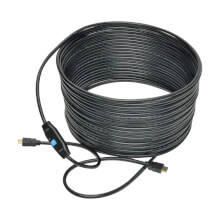
HDMI Cablevision Length
Passive Cables – Opinions vary over the maximum length of a passive HDMI cable. Consensus seems to be most fifty feet for 1080p and 25-feet for 4K video, but distances of over 50-anxiety are achievable. A good practical approach is to endeavor a passive cablevision and, if y'all have problems with betoken forcefulness, add an in-line indicate booster at the receiver end. Tripp Lite Model Number B122-000-4K6 will boost a 4K/lx Hz signal up to 50-ft and B122-000-60 volition extend a 1080p/threescore Hz signal up to 125-ft.
Active Cables – Length is more definitive in the example of an active cable because bespeak transmission is designed and tested over the advertised distance. For example, Tripp Lite'due south P568-065-ACT active HDMI cable volition support video transmission up to 65-ft.
HDMI Extenders
When transmission distance requirements exceed the limits of passive and active cables, it'south time to consider the various forms of signal extension.
In-Line HDMI Signal Extender – For distances upward to 50-feet, an in-line blaster or repeater can extend a 4K/60 Hz signal up to 50 feet and a 1080p/sixty Hz signal upwardly to 125-ft. Greater distances are possible at lower frame rates.
HDMI over Cat5 and Cat6 – A Cat5/6 extender will catechumen the HDMI signal into similar Ethernet IP packets that tin be transmitted over the category cable and reconverted at the other end with no loss of betoken force or fidelity. Using this arroyo, an HDMI signal can be transmitted most 3 times farther than an active HDMI cablevision–approximately 100 meters (328 ft.). Shielded (STP) Cat6 cable is recommended for its ability to reduce EMI interference from ability lines and crosstalk within the cablevision.
HDMI over Fiber – The connectors on fiber HDMI convert conventional electrical inputs to pulses of lite that are transmitted at high speed through optical fiber, then converted back to electricity on the receiving stop. Since signal transmission is optical, it isn't subject area to EMI/RFI line noise. HDMI over Fiber tin can be extended well beyond the 100 meter/328-human foot limit of copper Ethernet cablevision.
Wireless HDMI Extenders – A hardwired extender uses an Ethernet or Active Optical Cablevision to laissez passer data betwixt a transmitter and receiver. A wireless extender sends the HDMI signal using ane of the WiFi protocols (e.g. 802.11ac or 802.11n). Wireless is more often than not slower than hardwire so brand certain the video resolution and frequency is sufficient for your needs. For example, Tripp Low-cal's B127-1A1-WHD1 can extend a 4K/30 Hz signal up to 98-ft.
Converting To and From HDMI
HDMI and Thunderbolt 3
Can I connect a TB3 port to an HDMI display?
Yes, just not directly. Thunderbolt 3 has native back up for DisplayPort and from DP you can become to HDMI by style of an adapter. You can also use an adapter cable like Tripp Lite's U444-006-H4K6BE to convert DP Alt Way to HDMI.
HDMI to DisplayPort / DisplayPort to HDMI
Can I connect DisplayPort to an HDMI brandish?
Yes, a DisplayPort to HDMI adapter cablevision allows you to connect a computer with DisplayPort video output to an HDMI-enabled monitor or TV. If yous use a passive cable, make sure the video source is a DP++ (DisplayPort ++) dual-mode port. If your graphics menu does not support DP++, use an agile cable such as Tripp Lite P582-006-Hd-V2A.
Can I connect a DisplayPort monitor to an HDMI port?
Yeah. Even though HDMI and DisplayPort apply different betoken protocols (TMDS vs. LVDS), it is possible to convert HDMI to DisplayPort with no loss of image quality using an active adapter. The adapter may require an external power source. The Tripp Lite P130-06N-DP-V2 4K HDMI to DisplayPort Active Adapter uses power from the USB-A port.
HDMI to DVI
Tin I connect an HDMI port to a DVI monitor?
Yes, HDMI and DVI video signals are compatible. An HDMI to DVI adapter will back up resolutions upward to 1920 10 1200. However, DVI will not support HDMI sound.
HDMI Alt Mode over USB Type-C
USB Alt Manner allows a USB-C connector or port to transmit not-USB signals, making it extremely versatile. For case, a laptop, Chromebook or Android phone might use Alt Mode to directly connect a USB-C port to an HDMI-enabled monitor without the need for an adapter. This is an important feature because many laptops and tablets have a USB-C port but no HDMI port.
To take advantage of HDMI Alt Way, y'all need a USB-C port that supports USB Power Commitment. It is the PD handshake that establishes an Alt Style connectedness. You volition also need a cable with a USB-C connector on one cease and a USB-C or HDMI connector on the other. Older USB-A cables exercise not support Alt Style.
Another selection is to utilise an adapter cable supporting DisplayPort Alternate Style, such as Tripp Light's U444-006-HDR4BE, to connect a USB-C port to an HDMI display.
Every bit a general rule, video and audio can be converted from ane protocol to some other equal or lesser protocol every bit the tabular array beneath shows. Protocol conversion requires an adapter.
Bluish: Standard cables and no protocol conversion
Green: Adapters and Adapter Cables
Switching and Splitting HDMI Signals
Switches and splitters are often confused and for expert reason. They perform similar functions. A switch takes multiple inputs and lets you choose which one to brandish on your Television set or computer monitor. A splitter does exactly the contrary. It takes a single video bespeak and replicates information technology to multiple displays.
HDMI Splitters
An HDMI splitter takes one HDMI video indicate and sends information technology to multiple displays. Each brandish will show the same image. Splitters are often classified co-ordinate to their inputs and outputs. For example, a 2-port splitter might be referred to as "1x2" considering it has 1 input and two outputs.
When choosing a splitter, make sure the output is at the resolution and frequency y'all desire. A video splitter may also perform protocol conversion, for instance, converting DisplayPort to HDMI.
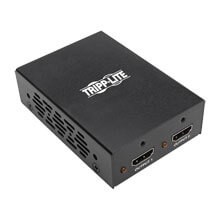
HDMI Switches
An HDMI Switch, too chosen a Presentation Switcher, outputs audio and video from multiple sources but but one at a time. For example, a boardroom presentation might include Powerpoint slides and video from a streaming service like YouTube or Vimeo.
A matrix switch has multiple inputs AND outputs. For case, a 9x2 matrix switch has 9 inputs and 2 outputs.
Some other variation on the many-to-one theme is the Multiviewer, which consolidates a number of video inputs on a single monitor. Multiviewers are institute in broadcast control rooms and video surveillance systems.
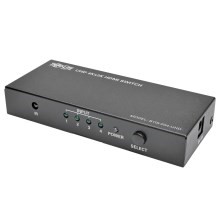
Tin I extend my desktop using an HDMI splitter?
No, an HDMI splitter takes one video signal and replicates it to multiple displays so each display shows the same prototype. This is known equally "mirroring". Hither are your options for extending your desktop:
- If your laptop has an bachelor DisplayPort or Mini DisplayPort port and you desire to add an external HDMI monitor, employ a DP or mDP to HDMI adapter.
- If you have a laptop with a USB-C port and want to add together an external HDMI monitor, consider a multiport adapter with an HDMI video port.
- If you have an available USB-C or Thunderbolt port and want to add two or three external monitors, utilise a dock.
HDMI Surge Protectors
A power surge is typically a brief increment in voltage due to, for example, an overloaded excursion, ability outage or lightning strike. A surge protector detects excess voltage and safely diverts information technology through the building'southward grounding arrangement so it doesn't harm connected equipment.
HDMI surge protectors are intended to supplement primary surge protection and are installed "in line" between a video source and display.
Important: surge protectors do non provide two-fashion protection against power spikes. If you want to protect both source and display, you should install two surge protectors: one with its output facing the video source and one with output facing the brandish.
Do in-line surge protectors dethrone the HDMI signal?
All in-line surge protectors introduce a pocket-size impedance into the line and a capacitance across the line. Tripp Lite'due south in-line HDMI surge protector (Model Number B110-SP-HDMI) is designed with lower line capacitance and impedance to avoid Transition Minimized Differential Signaling (TMDS) loss.
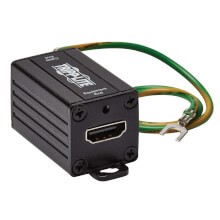
HDMI Sound Extraction
An HDMI signal includes both video and audio, which is convenient considering you need only ane cable to connect a cable box, game console or streaming device to your television. But if you want to play audio through an older analog sound organization that doesn't take HDMI support, you volition need to divide the audio track from the video. That'south where an sound extractor comes in.
An HDMI Sound Extractor splits an HDMI signal into a separate HDMI point and an audio output. Depending on the capabilities of the audio extractor, you lot may have the selection of compressed or uncompressed (LPCM) audio outputs, for example, three.5mm stereo or a multi-channel format like 7.i surroundings audio via TOSLINK.
When ownership an sound extractor, make sure the video and audio output formats match the capabilities of your television and sound system.
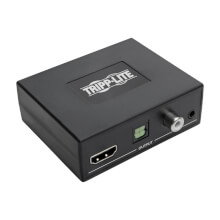
HDMI vs. DisplayPort
HDMI and DisplayPort are similar standards with a unlike focus. HDMI has been widely adopted by consumer electronics manufacturers. DisplayPort's main focus is computer connectivity and professional audio/video applications.
If you demand to connect a Blu-Ray player, cable box, game console or streaming device to your television, HDMI is the logical choice. Your options for connecting a estimator monitor to your laptop or desktop PC may be less clear. Many computers (and docking stations) offer both HDMI and DisplayPort. Which one volition give you the best results? In terms of paradigm quality, in that location isn't much deviation. DisplayPort 2.0 has a college bandwidth, allowing it to back up higher resolution video, just there are currently few applications requiring video beyond 4K. However, if you lot demand multiple displays, yous can daisy-chain iii 4K monitors @ 90 Hz or two 8K displays @ 120 Hz.
| HDMI 2.1 | DisplayPort 2.0 | |
|---|---|---|
| Released | 2017 | 2019 |
| Typical Application | Consumer TVs | Computer Monitors |
| Max. Transmission Rate | 48 Gbps | 77 Gbps |
| Max. Resolution (uncompressed) | 4K @ 144 Hz 5K @ 60 HZ 8K @ thirty HZ 8K @ 120 HZ (DSC*) | 4K @ 240 Hz 8K @ 120 Hz 16K @ threescore Hz |
* Display Stream Pinch (DSC)
What'south Side by side for HDMI: 16K Video?
With 8K TVs and cameras now readily available, beginning adopters are turning their attention to even higher resolutions, including 10K and 16K, and refresh rates above 60 Hz.
Bandwidth is the biggest barrier to higher resolutions and refresh rates. Ignoring all of the extra data layered on tiptop of the video itself, the unproblematic formula (resolution x refresh rate ten color depth) adds upwardly to a lot of $.25 which demand to exist moved from a video source to a display. An uncompressed 8K, 24-scrap color video point at threescore Hz needs almost fifty Gbps of information bandwidth.
The current HDMI specification tops out at 8K/120 Hz then a revision will be required to go beyond that.
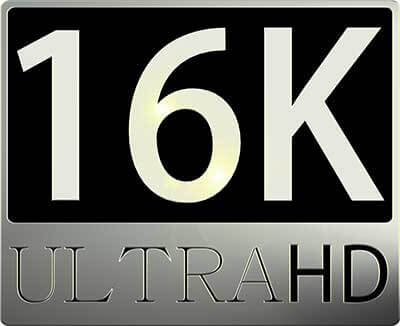
Products Mentioned in this Article
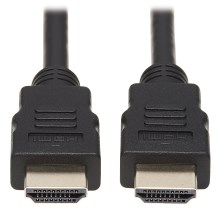
HDMI Cables
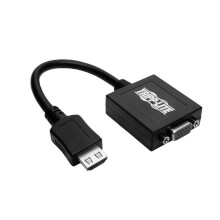
HDMI Adapters
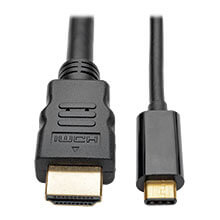
HDMI Adapter Cables
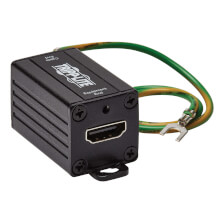
HDMI Surge Protectors
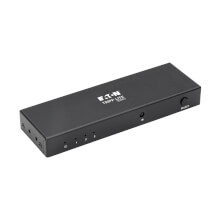
HDMI Switches
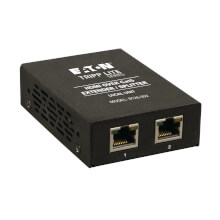
HDMI Splitters
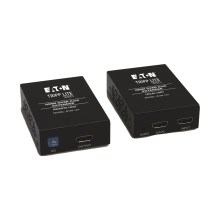
HDMI Extenders
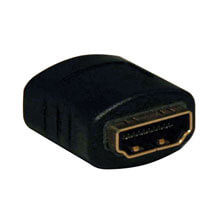
HDMI Couplers
Why Buy from Tripp Low-cal?
We know you lot accept many brands to choose from. On the surface, they may all seem alike. It'south what y'all don't see that makes the difference. With Tripp Lite, you get solid engineering science, proven reliability and exceptional customer service. All our products undergo rigorous quality control before they are offered for auction, and independent testing agencies verify our products meet or exceed the latest safety and performance standards. Our delivery to quality allows united states to back our products with industry-leading warranties and responsive customer service. Information technology'south the Tripp Light deviation.
Source: https://www.tripplite.com/products/hdmi-cable-types
0 Response to "How Do You Know if Your Hdmi Is 2.0"
Post a Comment